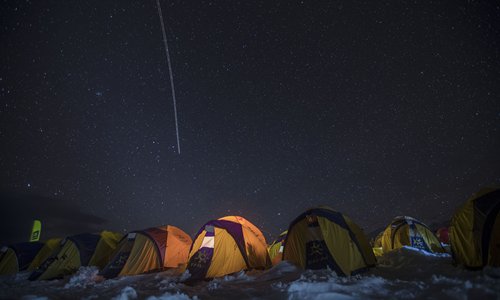
The Gangshika base camp (Photo: Fei Maohua/Xinhua)
The summer season has come early for many cities in China this month, leading many to think about ways to dodge the scorching heat. Now there is a new option they can consider: heading to the mountains.
In Northwest China's Qinghai Province, Mountain Gangshika offers travelers an experience that will make them think they have traveled through time: fresh snow on the highlands.
Getting to Gangshika is easy. From the provincial capital of Xining, it takes only about three hours by bus to reach the foot of the mountain. There's also a quicker option - take a high speed train to the station at the -Menyuan Hui Autonomous County and head out from there.
Gangshika, whose peak sits at 5,254 meters above sea level in the eastern part of the Qilian Mountains, is often considered a suitable place for beginning mountaineers.
But, make sure you are prepared for some altitude sickness - the foot of the mountain sits at an altitude of about 2,500 meters above sea level.
The road toward the peak of Gangshika - which literally means "the grandfather of snow mountains" in Tibetan - is rough, but it's still an ideal place if you are looking for an original nature experience.
The walking path starts at about 3,700 meters and involves a 3.4-kilometer trudge to a base camp at about 4,360 meters above sea level. Stones and snow cover the road, so it would be wise to bring an alpenstock with you.
Preparations
Try to keep your backpack as light as possible, but several things are necessary: sunscreen to resist the strong UV rays at high altitude and some hot water to keep yourself hydrated.
Do not forget to prepare some food. -Experienced mountaineers- recommend nuts, which are light in weight but high in calories.
It is always a good idea to wear waterproof clothing, including wearing gaiters, when hiking up a snowy mountain.
It was very snowy and windy the day I made it to the base camp. It took me about two and half hours to finish the 3.4-kilometer walk, and I had to rest by the side of the hiking path several times because I felt dizzy.
Don't try walking all the way nonstop. If you feel tired, take a break so you can catch your breath. Don't worry if you run out of water, you can always try melting snow.
Make sure you wear a hat to keep your head warm, which also helps combat altitude sickness.
Hiking does not have to be a one-man battle against nature. Feel free to link up to others who are taking the same path, that way if someone has any problems, the others can extend them a helping hand.
Camping in a tent
Though there is a wooden house at the base camp, but there were also plenty of tents pitched next to each other. Since I wanted to experience nature as much as I could, I chose to sleep in a tent rather than the wooden house.
Thanks to a horse caravan that brought supplies to the base camp, we had plenty of potable hot water as well as food inside the house.
Everyone at the camp must have been very hungry by dinner time after an exhausting day since they quickly polished off the food that was served in less than 10 minutes.
Mountaineering experts recommend you do not fall asleep before 10 pm, as the thin air in the mountains makes people wake up very early the next day. If you don't want to face a grueling sleepless night, just follow the rules.
I was also told not to pile up the snow to cover the rims of my tent, since that could keep fresh air from getting in the tent and lead to me suffocating.
Though I rigorously followed these suggestions, my first time tent-sleeping eventually turned out to be a disaster.
The strong wind - estimated to be at least a seven on the Beaufort scale - had forced snow into the tent.
My sleeping bag as well as my hat was entirely covered in a layer of white snow. It was a really weird feeling to feel that every part of me was warm, except my face as snowflakes continually fell on it.
The toilet is about 50 meters away from the wooden house, so plan your trips to answer Nature's call carefully.
There is no hot water to wash or brush your teeth, so you might want to bring some wet wipes.
Interestingly enough, it is forbidden to use toothpaste on the mountain. For this reason, some people decide to use salt instead.
Drinking plenty of hot water is a good way to lessen the nausea caused by altitude sickness. It's recommended that you drink at least four liters of water a day when at high altitudes.


















































